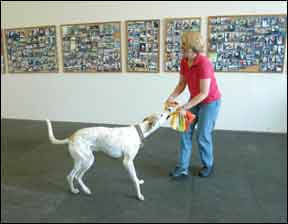[Updated August 22, 2017]
Food treats are an easy and effective reward for a dog when training. But food rewards are only one way to build strong behavior. There may be times when you do not want to or cannot use food, and there may be times when the best reinforcement is something other than a hot dog! Here are five great ways to reward your dog when you don’t want to reach for the treat pouch.
Ways to Train a Dog Without Treats:
1. Play with your dog!
Anyone who has trained for an active sport like agility or flyball knows the value of using toys, games, and play in training. But toys, games, and play don’t apply only to the sports-minded. Playing with your dog can be a powerful relationship-building tool, as well as a potent reward. Tugging and retrieving may be the most obvious play rewards, but playing games with your dog is limited only by your (and your dog’s) imagination.
2. Use “life rewards.”
These are things that your dog enjoys in his daily life, such as going for a walk, running in the backyard, or splashing in a sprinkler – and they can be harnessed by using the Premack Principle.
This principle says a “low-probability behavior” (one that the dog or other subject is less likely to perform, such as waiting calmly at the door) can be reinforced by a “higher probability behavior” (one that the dog prefers, such as getting to race happily around the yard). For example, to strengthen your dog’s sit, ask him to sit before giving him access to any of the things he really enjoys – running with his pals, swimming in the pond, or cuddling next to you on the couch. This type of reward is easy to integrate into your daily life, and can be especially helpful for dogs who need assistance with self-control.
3. Offer warm words to your dog.
Praise, “happy talk,” or a simple “Good dog!” may be the most common type of reward there is! Some dogs naturally find praise rewarding, but even dogs who don’t seem to can become praise seekers if you frequently pair your praise with other great things. For example, if you teach your dog to “down” with a click, followed by a treat or tug, you can add in “Good dog!” as you deliver the treat or play the game of tug. Soon, your dog will learn to associate that happy praise with the treat or tug, and “Good dog!” will become its own reward.
4. Touch him where he likes it.
Touch can be a wonderful reward for some dogs, but it is also a tricky reward to use. Before using petting, rubs, or massage as a reward, first consider two things: What types of touch does my dog enjoy? And, when does he enjoy being touched? For example, your dog might enjoy a chest scratch, but may shy away from a head pat. Long, slow strokes may feel good and be rewarding when he is settled next to you, but irritating if he is waiting for a run in the backyard. Pay attention to what your dog does when you touch him; if he ducks away or does not engage with you, it probably is not rewarding. If he engages, comes toward you, or asks for more, then it probably is rewarding.
5. Create space.
You can use space as a reward by increasing distance or by removing social pressure. In the right situation, space can be very powerful reinforcement. For example, a dog can be rewarded for an appropriate behavior (such as looking away) in the face of an anxiety-producing trigger (such as a scary person) when you increase distance by moving the dog away from the trigger. (This tactic, described as “Behavioral Adjustment Training” or BAT, is more fully discussed in Pat Miller’s article, “Dog-on-Dog Household Aggression,” in April 2010.)
In your day-to-day interactions with your dog, you can also use space in smaller or subtler ways by removing social pressure. If you are teaching your dog to stay out of the kitchen by using gentle body blocks, for example, you can reward your dog’s acceptance of the kitchen door boundary by simply backing up a little bit – or removing the social pressure of the body block.
These are just some of the many ways you can reward your dog when you don’t want to use food or treats. Remember, when you are thinking about rewards, you can consider anything your dog finds valuable
Mardi Richmond is a writer and dog enthusiast in Santa Cruz, California.







so I showed this treat to my dog and I did what it said to do and he sat that was the first time me and my mom have ever seen that and that was so amazing so the next thing I did was trie it without a teat and it took hime about tow minitutes
and he did it I mean that was good for his first try or was it I have a nother dog at home she already no’s that so thanks for the help